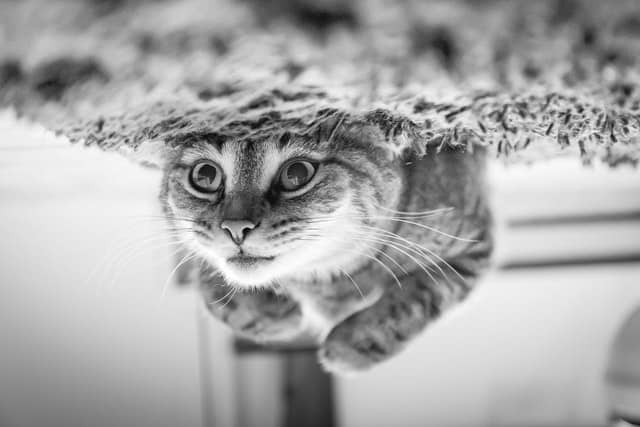
Want to know more about the various problems that can afflict your cat’s spine? Find out all the possible causes and treatments.
What are the postural problems a cat can suffer from? Problems with the spine due to congenital malformations of the spine and vertebrae. When as kittens they start to suffer from some defects, the problem may not be immediately evident, especially if it is our first experience of living with a cat. Unfortunately, the bones of cats are subject to fractures and malformations, so it will be necessary to contact the veterinarian immediately for a quick diagnosis as soon as we notice worrying signs of posture in our cat.
The backbone of the cat
By comparing the feline and human backbones, we will notice that there are two substantial differences: the first is in the number of vertebrae while the second concerns the clavicle. In the cat the number of vertebrae is greater, certainly also due to the presence of the tail: in all 7 cervical vertebrae, 7 lumbar, 3 sacral, 13 thoracic and caudal (of the tail) from a minimum of 14 to a maximum of 28. The second aspect concerns the absence of the clavicle in the feline, replaced by a small clavicular tissue hidden between the pectoral muscles. This is why the cat has a tighter and more flexible chest to creep into tight spaces. The feline musculature aids this flexibility of the skeleton and allows for arched movements and passages otherwise unthinkable for a ‘rigid’ skeleton.
Problems with the cat’s spine
Malformations of the vertebrae, bones, spina bifida and dysplasia are just some of the problems that can afflict our poor cat. These names may not tell us much, but reporting the symptoms could help us get a clearer picture of the situation to our trusted vet.
Malformation of the occipital bones
The atlas and axis are the first and second cervical vertebrae at the base of the feline skull. Usually a malformation compresses the spinal cord which causes total limb paralysis and imminent death.
The hemivertebra
It is an incomplete development of the feline body and vertebral arch, which is also very common in dogs. It is probably due to a lack of ossification of one half of the vertebral body, or to an abnormal distribution of the arteries that have not vascularized well. The hemivertebrae can be unilateral, dorsal or ventral.
Vertebra wedged
When the cat’s spine is visibly crooked and the vertebrae squeeze and form a wedge.
Lordosis, kyphosis and scoliosis
Structural deformations of the spine that tilt the normal curves of the spine unnaturally. Lordosis in humans is characterized by a deep hollowing of the spine in the lumbar region, with a backward pelvis and a curved spine. Kyphosis is a curvature of the spine that curves the back and brings the pelvis forward. Finally, scoliosis involves one or more curves of the spine which also appears rotated on itself.
Transitional vertebrae
In this case a vertebra assumes, in part or completely, the morphological typology of the underlying or overlying vertebra.
Vertebrae welded
In this case there are no obvious symptoms if one vertebra is welded to another, as in the so-called ‘butterfly vertebra’.
Spina bifida
It is a sacrococcygeal malformation, that is of the vertebrae of the lower part of the spine, consequently the tail is truncated.
Variable dysplasia of the spine
The cat will exhibit a weak gait due to the fact that its hind legs cannot support its weight. It is a dominant trait of the Manx cat, a feline breed characterized by a mutation of the spine. Its specimens lack part or all of the tail and have the hind legs longer than the front ones.
Myelodysplasia
A bone marrow dysfunction that is not regularly developed.
Causes of cat backbone problems
The reasons behind feline spinal malformations can be both genetic and acquired by the mother cat during pregnancy: in this case both toxins and food deficiencies may have determined a genetic malformation. Among the possible causes, the cat’s nervousness and stress must also be included.
Spinal problems: the diagnosis
Various and effective are the tools available to the veterinarian to diagnose the type of problem. First of all, the expert must have a very clear genealogical picture of the feline in question, know (from the owner) when and how the first symptoms appeared and then proceed to subsequent tests. Here are the technological tools available to the expert to define the clinical picture:
- X-ray radiography of the cat’s spine to identify and locate malformations.
- Myelography in severe cases such as paralysis: it serves to determine the possible compression of the spinal cord.
- Computed tomography
- An MRI
Cat’s backbone problems: treatment
Of course, whenever possible, there is adequate and specific treatment for every type of problem. In some cases surgery is recommended by the expert, but in the absence of other damage to the cat’s spine. Furthermore, surgery can only be considered if the problem is recognized in time. What we humans can do to help them is to guarantee the cat absolute rest and give him our affection.
Once the problem is diagnosed it will be necessary to schedule regular visits (approximately every 4 months) to the vet to note the progress. Subsequent x-ray radiographs will help assess the condition of the feline spine. Spinal problems are often accompanied by incontinence or constipation or by very annoying urinary infections: in this case we pay attention to the cat’s diet and to a cure of antibiotics.
If the cat has spinal problems
When we have a clear diagnosis of the cat’s spine problem, it will be better to prevent mating to prevent the offspring from developing spinal or vertebral malformations. Hereditary disorders should therefore ‘force’ the owner to sterilize the cat, precisely to preserve the species.
A hint of spondylosis
It is a degenerative disease of the cat’s spine: bone spurs (growths) form along it and prevent it from functioning properly. Although the quality of life may still be sufficient, cats may have problems with flexibility and dynamics: in practice it loses its elasticity. It could be due to aging and therefore present in the elderly cat, but also due to a genetic predisposition, overweight and intense efforts.
When the spurs develop they could form bridges: breaking these connections could damage the cat’s neurological system and force it to stiffen. Cats with spondylosis experience pain from making any type of movement, including when defecating. This disease will obviously have its repercussions also in the social life of the cat. Unfortunately, there is no cure for this type of problem, although in some cases surgery has yielded satisfactory results.
Fractures / dislocations of the cat’s spine

Often severe trauma such as falls from great heights and traffic accidents can compromise the spinal cord. They can create edema, internal bleeding and necrosis of the feline tissue, but also fractures and dislocations of the vertebrae. Of course, the treatment and healing depend on the specific case, but controlled physical activity has given good results. In other cases, surgery stabilized the injured vertebral segment.
The prognosis of cats with this type of fracture and injury depends not only on the situation itself, but also on the timeliness of surgery and the state of the other organs. The post-operative physiotherapy can vary from a few weeks to months, in which the cat will have to feel all our affection in order to face the pains and the necessary treatments.






